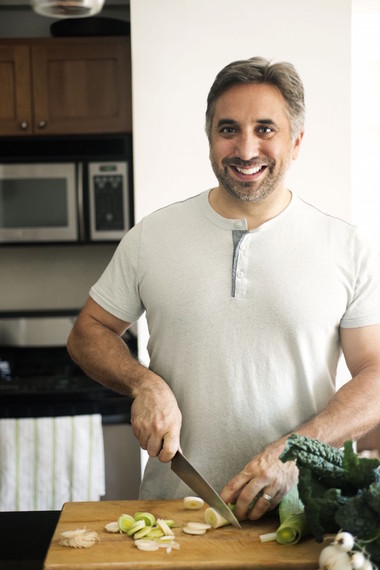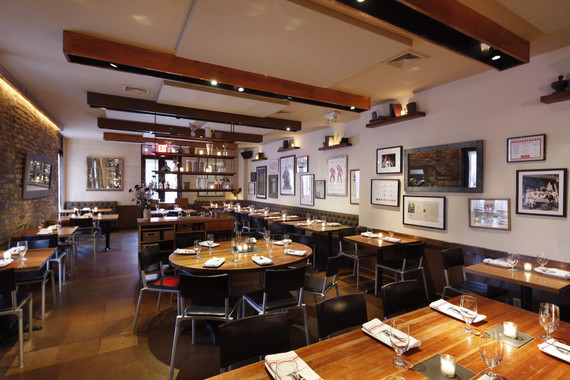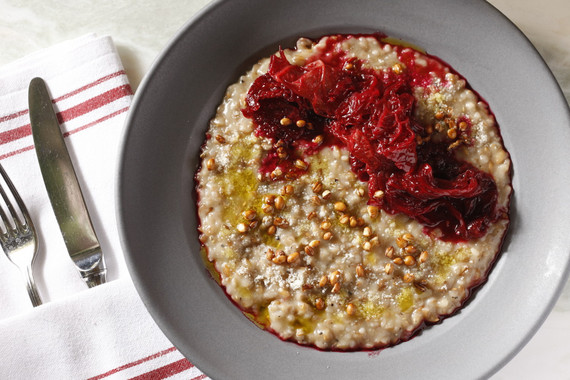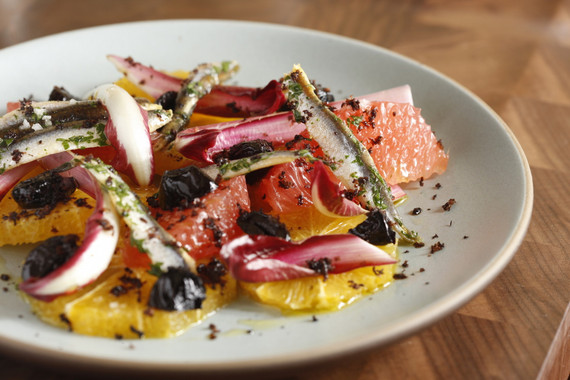In 2003, Chef Marco Canora, fresh from the helm of Tom Colicchio's Craft, opened a restaurant of his own -- Hearth -- a lovely, intimate East Village spot with an Italian sensibility and a Greenmarket-driven menu. The restaurant drew rave reviews and a loyal clientele.
Time passed. Canora got married, had two kids, and started taking better care of himself, paying serious attention to his own health and nutrition. He even wrote a book about it--A Good Food Day. He began drinking nutrient-dense Brodo, or bone broth. He was so impressed with its healing powers-- it is known to relieve arthritis, fight infections, build strong bones, support the liver in detoxing the body, and reduce inflammation overall -- that he opened Brodo, a streetside retail window at Hearth, and wrote a book about that, too.
With a new commitment to health and wellness, and a bustling side business selling bone broth, you'd think Canora might be ready to sit back and relax. Alas, no. Twelve years from the launch of Hearth, Canora was itching for change. The restaurant felt stale; the menu, overwrought. His commitment to farm-to-table ingredients, not strong enough. He had new ideas and wanted a stage to make them happen. Rather than close Hearth and start from scratch, he decided to revive the concept, closing down for a week, and relaunching anew.
Hearth re-opened on January 8th with a fresh new interior, reimagined hand-drawn graphics by artist Libby VanderPloeg, and a new menu without apps and entrées, but filled with small- and medium-sized plates in categories such as fish, vegetables, meat, broth, grains, and offal. The result is a restaurant that's new, yet familiar, and one that has been given a fresh start with a reinvigorated staff and a clientele eager to explore the unchartered landscape. It's an operator's dream.
Andrea Strong chatted with Canora about the art of reinvention, and the struggle to "put asses in the seats."
Why do Hearth 2.0?
There's a lot of different reasons. One is simple. We were 12 years old and we were open seven days a week. We were only closed about five days a year, and the place was rundown and needed a facelift.
For the last couple of years I was making changes little by little during the days, putting up shelves, painting a wall here and there. And I thought this was the right way to go because I would never have to close. But then, I reconsidered. I thought, I should close it down and do an unveiling and have a strategy in terms of marketing.
So, I decided to close for one week and revamp the menu, the graphics, the design of the restaurant. We decided if we bundled everything together we could make a bigger statement instead of doing it little by little and then no one really notices.
That's an awful lot to do in one week.
It was all in the planning, which took a lot of time -- nearly 10 months. We had the graphic redesign piece, in addition to renovating the restaurant. I was the GC (general contractor) on the job, and I hired and managed all my subs myself. We closed for eight days right after New Year's, which is one of the slowest weeks of the year. It's hard to make ends meet that week anyway because everyone is so overloaded from indulging, so it actually made sense to do the renovations then. We reopened January 8th.
What about the name of the restaurant? If you are going through all this change, why not change the name too?
I thought about it a lot. Ultimately I decided that Hearth had garnered so much in the way of love and support from our customer base and our industry, I felt it wouldn't have been a prudent move to get rid of all of that. Personally, it felt better to not let go of the name. I feel like it deserved to be refreshed and rebranded, and I looked at it as an opportunity to try to keep hold of the tenure and marry that to a relaunch and a newness. I thought it would be good combo punch.
Talk to me about the changes to the menu. You not only changed many of the dishes on the menu, you completely changed the format.
I didn't want to change what we do stylistically. Hearth is still deeply rooted in Italian cuisine and a kind of a "less is more" approach, but the app and entrée format was not really working anymore. When I go out to eat, I don't have an interest in entrée-sized dish. I don't want to eat 12 bites of the same thing. I was ordering three apps, so I constructed the menu the way I want to eat, and I think, the way other people want to eat.
Also, the price point was just too high. Our entrees at the old Hearth were $34 to $38, and if I wanted to do a clean veal dish it would go beyond $40, which is cost prohibitive. I had so much anxiety to go past this threshold, and it was a real problem with the neighborhood. It was not driving asses in seats. Now there are a few plates that are $6 to $7, like breads and chickpea pancakes. The more typical plates are $17 to $23, and some dishes for two are $50 to $60. It's a little more friendly to the eye.
The menu also reflects a change in my own philosophy about sourcing food.
I have always cared about local and sustainable and Greenmarkets, but now I have taken it a few steps further. If I am going to go out of my way to find the perfect pigs, how can I then go out and buy a big bag of commercial sugar?
They don't jive, the same goes with any highly processed food that surrounds the main protein. So we printed this really amazing infographic on the back of the menu that took me about eight months to devise but really reflects how we source our food. It was important to me to have this piece, because I just feel like we are in a time now where people want more transparency.
[The infographic includes Canora's back-to-the-land mission in cleverly hand-drawn snapshots like this: "Hearth Chefs Rules #1, 2, and 3: Serve real food that tastes, looks, and smells delicious; and perhaps most importantly Rule #4: Serve food that makes you feel good"; "Keeping in Clean (We never use meats that were fed antibiotics or growth hormones...)"; "Real Sweet (We lean towards natural sweeteners like honey, maple, and dates)"; "Freshly Milled (We mill our own flour and polenta from non-GMO heirloom varieties of grain)"; and more.]
How did you retrain your staff with this new menu format? Did you instruct them on informing diners on how to order now that the menu includes several choices in six food categories?
I was adamant about not having tableside talk. I didn't want any sort of lecture like, "We are small plates restaurant and foods comes out as it is ready." I told the staff to drop the menu, walk away, and have faith that New York City diners are going to figure it out. It's a f*cking menu, and people know how to eat, and if they are asked questions we need to answer them, but as a general rule no diatribe tableside.



